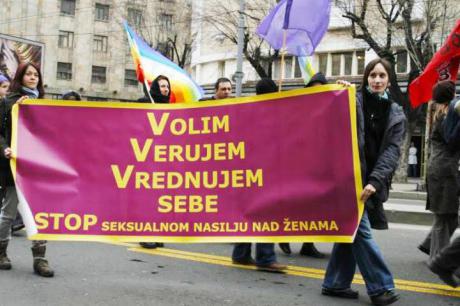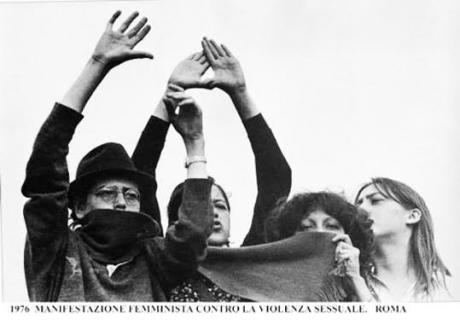Feminist lesbians have been passionate activists from the beginning of the movement against men’s violence and remain an inspiration for women to live independently of men.

Lesbian feminists with a banner "I love, I trust, I value Myself: Stop Sexual Violence Against Women". Belgrade.
I came out as a lesbian in the feminist encounters at the end of the eighties in Yugoslavia, a country which later dissolved through the nine years of war (1991-1999). At that time, some of us were passionate about ending patriarchy here-and-now and the first thing we started was to create women-only groups to empower women to get out of male violence. In Belgrade, we formed a feminist SOS Helpline for women and children survivors of violence in 1990, and we quickly realised that more than half of us were lesbians. There are similar stories from many places - Glasgow, Berlin, Bologna, Montreal….
Lesbians have been at the heart of the movement against men’s violence in many spaces across the world. From 1972, when the first Rape Crisis Centre was formed in Washington DC, lesbians were among the feminists who founded rape crisis centres and shelters for abused women in Europe, Latin America, US, Canada and Australia. I want to highlight this fact - that lesbians were and are engaged in the field of challenging men’s violence – but I also want to understand why this is important for lesbians themselves and for women dealing with legacies of violence.
To write this piece I talked with many feminist lesbians of my generation, aged 50-65, who were delighted to discuss an issue many had never been asked about before: “Tell me about you as a lesbian in the movement against male violence?” The first thing most said was that lesbians were a much higher proportion in anti-violence groups than in the general population, and that working there was a way to create their vision of ending the oppression of women. Some said: “We came up with women only groups, they were our safe place, maybe the only places one could actually work in women-only environment”. One noted: “We wanted to get as far away as possible from our families and the patriarchal world”. Many lesbians were inventing who they were without reference to male-dominated social structures, using the political ideas of the early lesbian authors, like Charlotte Bunch’s famous essay ‘Lesbians in revolt’ from 1972: “It is a primacy of women relating to women which is at the heart of women’s liberation”.

Feminist Action Against Sexual Violence, Rome 1976.
Some of us had experiences of male violence in our lives, because like many with a girlhood we suffered child sexual abuse before we became lesbians. On the other hand we are escapees of patriarchy who have chosen to put an end to emotional, sexual and economic dependence on men, and have started to invent different maps of living. Like the famous words in the "Woman-identified-woman" written by the Radicalesbians in 1970: ‘A lesbian is the rage of all women condensed to the point of explosion’’. The transformation of this rage for many lesbians meant supporting women to get out of male violence – this began 40 years ago and is still true today.
But this is not a simple story: initially many lesbians stayed silent in their collectives, because they were afraid. They were afraid of many things: that they would be accused of hating men; that the violence from men would be seen as the reason why they chose to love women. There were so many reasons for not talking: 40 years ago there were hardly any messages that it was good to be a lesbian, so we said it to each other, again and again, with loving tenderness.
But what is it historically that lesbians brought to this heterosexual civilisation, that Adrianne Rich in 1980 named ‘compulsory heterosexuality’? Firstly, the existence of lesbians per se means that heteronormativity is not the norm, but that norms are many. “We are different, we do not accept any compromise with male world. No mediation with them. We lesbians are creating a different space of liberty, where desire for women is central”, said Anna Pramstrahler from the Bologna anti-violence center.
I remember a few years ago in the Autonomous Women’s Center Against Sexual Violence in Belgrade, one woman who came for support was carefully observing the counsellors, especially the lesbians: “Some of you have a special kind of autonomy when you walk, when you talk… you are so different, I like it”. She noticed in our smiles, and maybe in our shoes too, that we were not leaning on men: from technical repairs of photocopy machines to guerilla actions, we were doing it on our own.
We lesbians offer an alternative model for women getting out of male violence, because lesbian feminists have no sexual or emotional investment in men, we demonstrate that independence is possible. This is a totally new field of freedom for some women – that there is a choice to live autonomously from men if they want to. This possibility gets limited visibility in mainstream responses to violence against women.
Many feminist lesbians, like Alix Dobkin, one of the first out lesbian singer-songwriters, believe “The first woman in your life is you”! That is the anti-patriarchal message that women get when organisations value their lesbian staff and volunteers.
Lately, Roma groups working on men’s violence have another dimension to deal with. In Roma, and many other communities, girls are given to so called ‘early marriages’. Their adult life often starts with rape at age of 14 or 15. There is no choice of sexuality here, it is a brutal example of the criminal aspect of compulsory heterosexuality. Danica Jovanovic, coordinator of Romnjako Ilo - a group for non-heterosexual Roma women in small town in Serbia, Novi Bečej - said: “For us Roma women it is crucial to have lesbians working with women who escape violence. Our young women never had the possibility to love women, they are sold at 14, and only at age of 30 or so, when they are free from perpetrators, they have a chance to choose. But there is no choice unless they have models of lesbians in front of them.”
Today, when many specialist violence against women organisations have become professionalised it is important to remember that the needs of women escaping violence reflect the same crucial values of the feminist
movement as before: The truth is that creating women only spaces is as essential as it was with the first rape crisis centers. Women need each other to speak about their experience when men are not present. It is as simple as that. We also need feminist approaches in counseling which take women’s autonomy as a foundation. We need passionate activists who are role models as lesbians, Roma women, black women, migrant women, women with disabilities. In order to make our dreams come true: to see all women free.
(Lepa Mladjenović is a feminist counsellor for women surviving male violence and war, and specialises in counselling lesbians. She is an anti-war activist and a co-founder of the Autonomous Women’s Center, Women in Black, Labris, Counseling for Lesbians, and writer from Belgrade).
This article was first published op openDemocracy.



